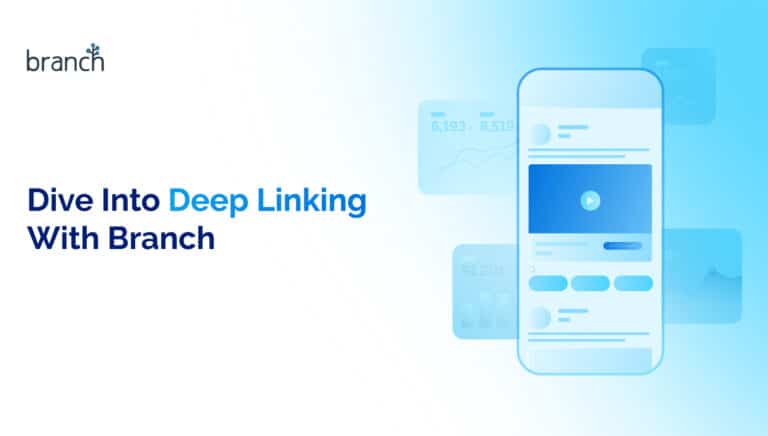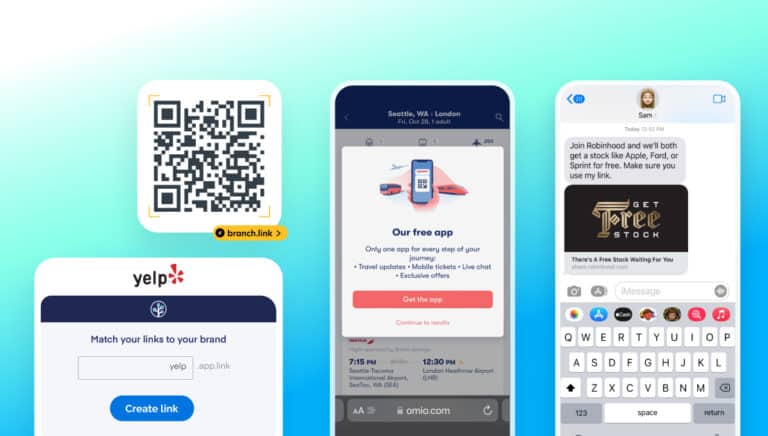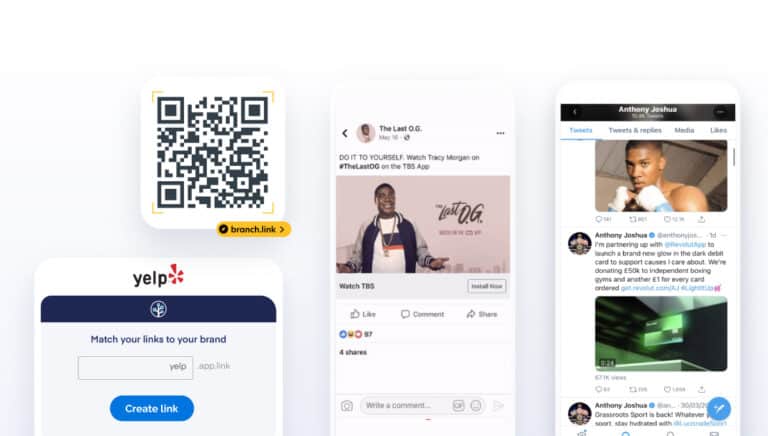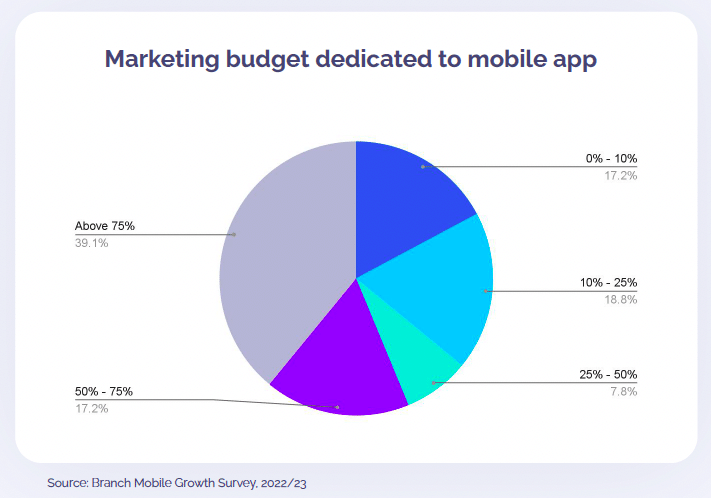MOBILE DEEP LINKING
What is mobile deep linking?
Rely on deep links to take mobile users to the right content, on the right channel, every time
App developers and mobile marketers are on a perpetual mission to provide simple and seamless ways for users to get to their mobile apps. They’ve learned that the fewer clicks required, the better. To remove unnecessary friction, they rely on deep links to take users to the right content, on the right channel.
But what are mobile deep links, and how do they work? Deep linking is technology that sends users directly to a specific page when they click on a link (e.g., branch.io/resources/), rather than directing them to a generic home page (e.g., branch.io). In mobile marketing, deep linking takes app users from a link directly to specific content inside an application they’ve already downloaded. This allows users to quickly go from one location (email, web, social) straight to the in-app content they want.
Sounds simple, but as the mobile ecosystem gets more complex, deep links have become a critical part of app marketing strategies and app development. To maximize the value of mobile apps, brands need deep links to drive installs, user engagement, and conversions.
Let’s look at an example. If a retailer advertises a sale on a particular brand of shoes, they can use a deep linking tool to create a special URL that takes the user to the precise product page in their mobile app to purchase the shoes. Without deep linking, the customer might click on the link, be taken to the mobile web, and be prompted to log in — even though they already have the retailer’s app. Or, a new user without the app might be routed to the app store, download the app, then open it to find the app home page, not the shoes they wanted. All these frustrating experiences and extra steps reduce the likelihood of app installs and conversions.
Mobile deep linking basics
There are various ways to deep link users to app content. Custom URI schemes were one of the earliest methods used until Apple and Google introduced their own deep linking technologies. These four components are key to understanding deep links:
URI Schemes
Initially, mobile apps employed custom URI schemes for deep linking. These schemes created a unique “private internet” for each app, utilizing links formatted as myapp://path/to/content. The advantage of custom URI schemes was their easy setup, since most apps already had one in place. However, they had a significant drawback: a user’s device could only recognize and handle these “private internet” links if the corresponding app was already installed. Furthermore, there was no inherent fallback mechanism available.
Universal Links
To address the limitations of custom URI schemes, Apple introduced Universal Links with iOS 9. A Universal Link functions as a standard web link (e.g., https://mydomain.com) that can direct users to both a web page and a specific content item within an app. When a Universal Link is accessed, iOS checks if any installed app is associated with the corresponding domain. If an app is registered, it immediately launches without loading the web page. If no matching app is found, the web URL — which can be a straightforward redirect to the App Store — is loaded in the Safari browser.
App Links
Google developed App Links as the Android counterpart to Apple’s Universal Links. An App Link functions similarly: it utilizes a standard web link that leads to both a web page and a specific content item within an app. This approach enhances the user experience by providing seamless integration. Despite its advantages, App Links have not gained widespread adoption because Android devices still support custom URI schemes.
Install Referrer
An Install Referrer is a string of code that can be appended to any link directing users to an Android app store. When the app is installed, the store retains the referrer data. This information can later be retrieved from the app and used to attribute the installation to its originating source. The Google Play Install Referrer is the most commonly used variant, although other Android app stores also support their own versions.
Benefits of deep linking
Deep linking enables better user experiences by connecting users to their desired content, facilitating personalized experiences and interactions, and breaking down app barriers. Plus, data from deep links allows marketers to better understand user behavior to continuously optimize user journeys.
Reduce friction
Deep linking optimizes user experiences by saving users the time and effort required to hunt for their desired content. By streamlining the user journey, deep links can boost user engagement and conversion rates.
Personalize experiences
Deep links enable marketers and app developers to create personalized experiences by targeting relevant content and campaigns to users based on their demographics, geographic locations, interests, and other variables. By customizing user journeys, marketers increase the likelihood of app downloads and improve retention.
Break out of walled gardens
Deep linking also provides a smooth transition between apps thanks to cross-platform integration. For example, deep links can take a user from an influencer’s Instagram post to a specific page within a brand’s shopping app. Without deep links, the user gets stuck in the walled gardens of in-app internet browsers on social media platforms.
Unlock user behavior insights
Beyond providing better experiences for users, deep links help marketers measure the effectiveness of marketing campaigns. They have specific tracking parameters that allow marketers to gather data on user behavior, such as the number of clicks, installs, and in-app purchases generated from specific campaigns or channels. Plus, deep links enable accurate attribution, so marketers know which campaigns drove app activity.
Mobile deep linking tools
Creating, organizing, and tracking deep links can quickly become a complex process when you add in more campaigns, channels, and content types. Savvy marketers turn to mobile deep linking tools to help streamline and automate deep linking workflows. Deep linking tools take the complexity out of supporting different platforms by enabling deep links to work everywhere, regardless of competing standards, functionality, and requirements for implementation. These tools can create everything from one-time deep links for a simple social post to dynamic links for omni-channel campaigns. Some deep linking solutions have analytics capabilities, too, providing insights into link performance, user behavior, conversion metrics, and overall campaign performance.
Most tools offer support for multiple platforms, such as Android deep linking and iOS deep linking. Though the mechanisms are similar, the two platforms behave differently. Android deep linking uses App Links to take users to Android apps. They require integration with Android’s operating system and the app’s manifest file. On the other hand, iOS deep linking uses Universal Links to accomplish the same thing. They involve configuring the app’s domain and creating a special file on the website to associate it with the app. Android and iOS deep linking also use distinct URL formats and handle links differently. Plus, each platform has its own set of deep linking standards.
Understanding deferred deep links
In certain instances, when a user clicks on a deep link, they may not have the destination app installed yet. This is where deferred deep linking comes in. Deferred deep links are a different type of deep link that can detect if a user needs to install the app and routes them to the Apple App Store or Google Play Store accordingly. Once they download the app, the deep link opens the intended in-app content.
Without deferred deep linking, a user might have received an error message or been left with a broken URL. Because deferred deep linking allows users to install an app before arriving at the destination of the deep link, it facilitates smoother user experiences while boosting install rates for app developers and marketers.
Why every app should use deep links
56% of respondents to our Mobile Growth survey dedicated more than half of their marketing budget to their mobile app — as opposed to web, desktop, and other platforms.
There’s an easy way to recoup some of the effort and resources dedicated to marketing mobile apps — deep linking. Deep linking and deferred deep linking are essential to cultivate superior mobile experiences, which will in turn help mobile marketers acquire app users cost effectively, drive in-app engagement, increase conversions, and eliminate data blind spots.
Dive Into Deep Linking

Deep Linking Benefits and Best Practices

How To Find The Right Deep Linking Solution


